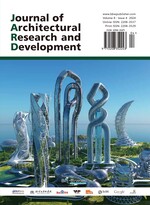The Study on the Evolution of Urban Spatial Structure in Zhuhai City Based on Spatial Syntax
Abstract
With the deepening of the Guangdong-Hong Kong-Macao Greater Bay Area strategy and the accelerated integration and development of the east and west sides of the Pearl River Estuary, Zhuhai’s hub position is becoming more and more prominent. The city of Zhuhai has a dense water network and is divided into two urban areas, the east and the west, under the influence of the Mordor Gate waterway. Based on the theory of spatial syntax, this paper carries out an analytical study on the urban spatial structure of Zhuhai, identifies the distribution characteristics of urban POIs, and provides theoretical support for the urban development of Zhuhai.
References
Xu Y, Chen X, 2021, Quantitative Analysis of Spatial Vitality and Spatial Characteristics of Urban Underground Space (UUS) in Metro Area. Tunnelling and Underground Space Technology, 2021(111): 103875. https://doi.org/10.1016/j.tust.2021.103875
Yamu C, Nes AV, Garau C, 2021, Bill Hillier’s Legacy: Space Syntax—A Synopsis of Basic Concepts, Measures, and Empirical Application. Sustainability, 13(6): 3394. https://doi.org/10.3390/su13063394
Blanchard P, Volchenkov D, 2008, Intelligibility and First Passage Times in Complex Urban Networks. Proceedings of the Royal Society A: Mathematical, Physical and Engineering Sciences, 2008(464): 2153–2167. https://doi.org/10.1098/rspa.2007.0329
Batty M, 2022, Integrating Space Syntax with Spatial Interaction. Urban Informatics, 2022(1): 4. https://doi.org/10.1007/s44212-022-00004-2
Nag D, Sen J, Goswami AK, 2022, Measuring Connectivity of Pedestrian Street Networks in the Built Environment for Walking: A Space-Syntax Approach. Transportation in Developing Economies, 2022(8): 34. https://doi.org/10.1007/s40890-022-00170-7
Sharmin S, Kamruzzaman M, 2017, Meta-Analysis of the Relationships Between Space Syntax Measures and Pedestrian Movement. Transport Reviews, 2017(38): 524–550. https://doi.org/10.1080/01441647.2017.1365101
Pafka E, Dovey K, Aschwanden GDPA, 2018, Limits of Space Syntax for Urban Design: Axiality, Scale and Sinuosity. Environment and Planning B: Urban Analytics and City Science, 2018(47): 508–522. https://doi.org/10.1177/2399808318786512
Rashid M, 2022, On Spatial Mechanisms of Social Equity: Exploring the Associations Between Street Networks, Urban Compactness, and Social Equity. Urban Science, 6(3): 52. https://doi.org/10.3390/urbansci6030052
Li Q, Cui C, Liu F, et al., 2021, Multidimensional Urban Vitality on Streets: Spatial Patterns and Influence Factor Identification Using Multisource Urban Data. ISPRS International Journal of Geo-Information, 11(1): 2. https://doi.org/10.3390/ijgi11010002
Sun G, Webster C, Zhang X, 2019, Connecting the City: A Three-Dimensional Pedestrian Network of Hong Kong. Environment and Planning B: Urban Analytics and City Science, 2019(48): 60–75. https://doi.org/10.1177/2399808319847204

